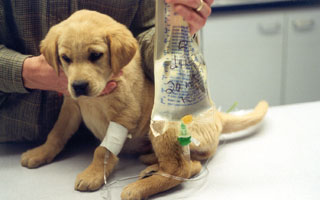Parvo is a disease that
causes great concern to both puppy owners and veterinarians. The reason for this
concern is that parvo is very contagious and is often life threatening for the
puppy or adult dog.
Puppies are the group most at risk for infection with
parvovirus. The most severe
infections usually occur in puppies less than 12 weeks of age. While all breeds
of dogs may suffer from parvovirus infection, Rottweilers, Doberman Pinschers,
and Staffordshire Bull Terriers (Pit Bulls) are particularly susceptible and
more difficult to treat.
Causative Agent: Canine parvo is caused by a virus called canine
parvovirus strain 2 (CPV-2). The virus is resistant to most common household
disinfectants and cleaning agents. The most readily available exception to this
is common household bleach (sodium hypochlorite), diluted to 1 part bleach and
30 parts water. This solution must be left in contact with the virus for a
prolonged period (at least 10 minutes) to be effective.
Clinical Signs: Domestic dogs, coyotes, and other canids are susceptible
to CPV-2 infection. The virus principally infects two main tissues: the
digestive tract and the heart muscle. When the virus infects the digestive
tract, the first clinical sign is usually vomiting, quickly followed by
decreased appetite, lethargy, diarrhea, and dehydration. The
stool may or may
not have streaks of blood present. Death may occur as early as 2 days after the
illness begins. When the virus infects the heart muscle, clinical signs include
difficulty breathing, gagging, crying constantly, or sudden death.
Disease Transmission: This usually occurs from direct contact with
infected dogs or contact with contaminated stool. Even minuscule amounts of
contamination can be infective. A mere footprint left by someone who has had
previous contact with an infected animal can spread the disease. Transmission
can also occur in the womb if the pregnant female contracts the disease.
Diagnosis: Diagnosis is usually made with a quick in-hospital test (see
page D621). Only a small fecal sample is required. It is important to note that
some parvo vaccines will cause a mild positive result on many of these parvo
tests. There are also blood tests and tissue cultures available for the
detection of CPV-2.
Treatment: Treatment centers on immediate correction of dehydration and
prevention of secondary infections. This involves administration of antibiotics
and IV fluid therapy. Some dogs may also be infected with internal
parasites
that tend to complicate the recovery. When this is suspected, de-worming is
often included in the treatment. Proper veterinary care and hospitalization are
critical for puppies infected with CPV-2.
